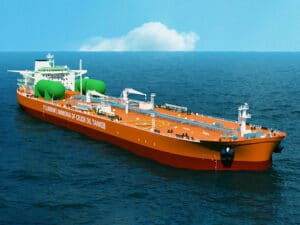
Overhaul inspection of ME-GI engine draws U.S. operators
Written by Marine Log Staff APRIL 19, 2013—Following up on the full scale demonstration of the ME-GI on April 17, Japan’s Mitsui Engineering & Shipbuilding Co. Ltd. hosted a group that included ship owners, operators, and naval architects for a first-hand overhaul inspection of the engine at its Tamano Works facility. The inspection tour gave guests an opportunity to have full access to the engine, including an examination of the cylinder heads and liners, cylinder covers with the gas blocks, adapter blocks and chain pipes.
APRIL 19, 2013—Following up on the full scale demonstration of the ME-GI on April 17, Japan’s Mitsui Engineering & Shipbuilding Co. Ltd. hosted a group that included ship owners, operators, and naval architects for a first-hand overhaul inspection of the engine at its Tamano Works facility. The inspection tour gave guests an opportunity to have full access to the engine, including an examination of the cylinder heads and liners, cylinder covers with the gas blocks, adapter blocks and chain pipes.
Operators examine ME-GI engine during overhaul inspection at Mitsui Engineering & Shipbuilding
There was a strong showing among participants by North American interests. Invited by MAN Diesel & Turbine,some of those in attendance were U.S.-based Crowley Maritime, Horizon Lines, Matson, Pasha, and SEACOR Ocean Transport, who operate oceangoing tonnage in the Jones Act trade, as well as U.S. naval architectural and marine engineering firm Hebert Engineering. Also on hand was Anglo-Eastern Technical Services, which manages a vessel for Canada’s Fednav International Ltd.
At right, operators examine cylinder heads from ME-GI engine
Stricter environmental regulations, including the implementation of an Emissions Control Area (ECA) around the contiguous United States and most of Canada, combined with the soaring cost of low sulfur fuel, has operators thinking about alternatives such as operating on relatively inexpensive, abundant, clean-burning Liquefied Natural Gas (LNG).
ACTIVITY IN THE U.S.
TOTE, Princeton, NJ, has already jumped into the LNG pool, ordering two 3,100-TEU containerships from NASSCO, San Diego, CA. Each ship will be outfitted with a single, two-stroke 8L70ME-C8.2-GI main engine. When delivered in 2015 and 2016, those ships will operate between Jacksnoville, FL, and San Juan, PR.
In addition, TOTE announced plans to convert two ORCA Class RO/RO ships to burn LNG. Called the Midnight Sun and North Star, the RO/RO ships operate between Tacoma, WA, and Anchorage, AK. The vessels are twin-screw, diesel-electric with total installed power of 52.2 MW. Each vessel has four MAN B&W 9L 58/64 main engines and two MAN B&W 9L 27/38 medium speed diesels at 400 and 720 rev/min, respectively. The diesel engines are designed to operate on both Heavy Fuel Oil, ISO 8217 Grade RMH 55 or Marine Diesel Oil, ISO 8217 Grade DMC.
 At left, No. 4 cylinder liner from ME-GI engine
At left, No. 4 cylinder liner from ME-GI engine
In the coastal and offshore markets in the U.S., Harvey Gulf International Marine (HGIM), New Orleans, LA, is building five dual fuel Platform Supply Vessels at TY Offshore in Gulfport, MS. Those PSVs will feature four-stroke, medium-speed Wartsila 34DF engines. New York City Department of Transportation (NYCDOT) is also moving towards the conversion of one of its existing ferries, a 1,200-passenger Alice Austen Class boat, to burn LNG. it’s received federal money towards the project. Classification society DNV is assisting Washington State Ferries (WSF) on the study to convert six of its Issaquah Class ferries to LNG.
The large contingent of North American operators is a clear indication that more LNG newbuilds and retrofits are in the pipeline. The real hurdles that lie ahead for the U.S. market aren’t the technology, but rather bunkering infrastructure, training and U.S. Coast Guard regulations.
ENGINE DEMONSTRATION
As we reported in our story on April 17, Mitsui Engineering & Shipbuilding (MES) in cooperation with the engine’s owner Mitsui O.S.K. Lines, temporarily converted the Mitsui MAN B&W 6S70ME-C to an ME-GI to demonstrate the two-stroke engine’s ability to switchover seamlessly from fuel oil to gas and back again.
The ME-GI is a diesel cycle dual fuel engine. Using a small amount of pilot fuel oil is necessary to ignite the injected gas to start the combustion process with the proper timing.
Besides the engine demonstration, MES allowed guests to tour a Fuel Gas Supply System (FGSS) for the ME-GI engine at the Tamano facility. The FGSS included a 100 cubic meter LNG tank, air fin tube, transfer pump, heat exchanger, suction drum, cooling tower, hydraulic drive unit, gas combustion unit, high pressure LNG pump, CNG bottle and an liquid nitrogen tank.
Safety is paramount when operating on gas. When the gas is fed into the engine room by the FGSS, it passes through a double wall pipe. The space between the inner and outer pipes is well ventilated with air taken in from outside the engine room. A gas sensor is used to detect any gas leakage in the space. Also, the ventilation air flow is monitored. When not operating on gas, the gas line down stream of the gas valve train is purged with inert gas.
The engine overhaul inspection by the group of operators and engineers followed a half-day program on April 18 hosted by MAN Diesel & Turbo in which presentations highlighted the development, design and fuel gas supply systems for two-stroke ME-GI (electronically controlled, gas injection) engines.
The presentations included “New Technologies,” by Soeren H. Jensen, Vice President, R&D, MAN Diesel & Turbo; “Detailed Design of ME-GI,” by Lars Juliussen, R&D, MAN Diesel & Turbo, and “Gas Supply System and Installation,” by Rene S. Lauersen, Promotion & Customer Support, MAN Diesel & Turbo. Les Gingell of MAN Diesel & Turbo North America, served as the moderator and provided opening remarks for the seminar.





Leave a Reply
You must be logged in to post a comment.